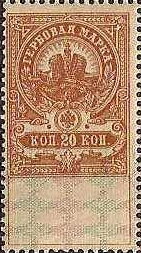Stamp: Revenue used as stamp - Crown (Russia 1918)
Revenue used as stamp - Crown (Russia 1918)
01 January (Russia ) within release Revenues used as stamps goes into circulation Stamp Revenue used as stamp - Crown face value 20 Russian kopek
| Stamp Revenue used as stamp - Crown in catalogues | |
|---|---|
| Michel: | Mi: RU 141A |
| Unificato: | Un: RU M7 |
Stamp is square format.
Also in the issue Revenues used as stamps:
- Stamp - Revenue used as stamp - Crown face value 50;
- Stamp - Revenue used as stamp - Crown face value 75;
- Stamp - Revenue used as stamp - Crown face value 10;
- Stamp - Revenue used as stamp - Crown face value 15;
- Stamp - Revenue used as stamp - Crown face value 20;
- Stamp - Revenue used as stamp - Crown face value 1;
- Stamp - Revenue used as stamp - Crown face value 1.25;
- Stamp - Revenue used as stamp - Crown face value 2;
- Stamp - Revenue used as stamp - Crown face value 3;
- Stamp - Revenue used as stamp - Crown face value 5;
Stamp Revenue used as stamp - Crown it reflects the thematic directions:
A coat of arms is an heraldic visual design on an escutcheon (i.e. shield), surcoat, or tabard. The coat of arms on an escutcheon forms the central element of the full heraldic achievement which in its whole consists of shield, supporters, crest, and motto. A coat of arms is traditionally unique to an individual person, family (except in the United Kingdom), state, organisation or corporation.
In British heraldry, a coronet is any crown whose bearer is less than sovereign or royal in rank, irrespective of the crown's appearance. In other languages, this distinction is not made, and usually the same word for crown is used irrespective of rank (German: Krone, Dutch: Kroon, Swedish: Krona, French: Couronne, etc.) In this use, the English coronet is a purely technical term for all heraldic images of crowns not used by a sovereign, and implies nothing about the actual shape of the crown depicted. A Coronet is another type of crown, but is reserved for the lower ranks of nobility like Marquesses and Marchionesses, Earls and Countesses, Barons and Baronesses, and some Lords and Ladies. The specific design and attributes of the crown or coronet signifies the hierarchy and ranking of its owner.


